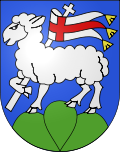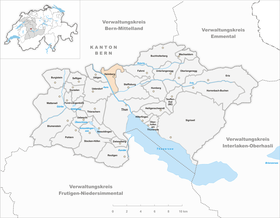Heimberg BE
| BE is the abbreviation for the canton of Bern in Switzerland and is used to avoid confusion with other entries in the Heimberg name . |
| Heimberg | |
|---|---|
| State : |
|
| Canton : |
|
| Administrative district : | Tuna |
| BFS no. : | 0928 |
| Postal code : | 3627 |
| Coordinates : | 612 474 / 182105 |
| Height : | 551 m above sea level M. |
| Height range : | 540–792 m above sea level M. |
| Area : | 5.44 km² |
| Residents: | 6832 (December 31, 2018) |
| Population density : | 1256 inhabitants per km² |
| Website: | www.heimberg.ch |
| Location of the municipality | |
Heimberg is a municipality in the Thun administrative district in the canton of Bern in Switzerland. The name is probably a formation from the Old High German personal name Haimo / Heimo and the generic word Berg .
geography
Heimberg is the lowest municipality in the Aare valley that belongs to the Bernese Oberland . The hamlets of Bümberg and Thungschneit belong to the community (the latter was an independent community until 1869), which are located northwest of Heimberg.
The municipality is one of the northern suburbs of the city of Thun . Neighboring communities of Heimberg are Fahrni , Steffisburg , Thun, Uetendorf , Uttigen , Kiesen , Brenzikofen and Oppligen .
history

In 1146 a knight Burkhart von Heimberg appeared as a witness in a document; this is also Heimberg's first mention and is considered to be the hour of birth of the community. Heimberg developed very strongly in the 18th century through pottery . The pottery industry reached its peak between 1800 and 1850.
Historically documented names of names:
- 1146: [Burchardus de] Heimberc
- 1175: Heimenberc
- 1250: Heinberch
- 1342: in the village of Ze Heimberg
In 1869 the previously independent municipality of Thungschneit was merged with Heimberg.
In 1992 Heimberg signed a friendship agreement as a partner municipality with the city of Horažďovice in the Czech Republic (South Bohemia). Since then, mutual contact has been maintained at the authority, club and school level.
In 1996 Heimberg celebrated its 850th birthday with a big party with a parade and various other activities. A new Heimberger book was published on this occasion.
pottery
The Heimberg / Steffisburg region was the most important pottery location in the canton of Bern in the late 18th and 19th centuries . On the road from Bern to Thun in the former administrative district of Thun, together with a number of neighboring villages from the administrative district of Konolfingen - Jaberg , Kiesen , Oppligen , Diessbach , Wichtrach and Münsingen - there were temporarily a maximum of 80 potteries. Heimberg itself had 234 inhabitants in 47 households in 1764. The directly neighboring Steffisburg had 924 inhabitants in 184 households. By 1856 the number of households in Heimberg alone rose to 234 with 1,217 inhabitants. In 1880 Heimberg had 1149 and Steffisburg 3898 inhabitants.
Ceramic production in the Heimberg region began around 1730. At this point in time, Abraham Herrmann (1698–1750) moved from Langnau with his family to Heimberg and later to Steffisburg. He was followed around 1752 by his younger brother Peter Herrmann (1712–1764). The oldest archival records for Abraham Herrmann date from April 29, 1731. It can only be assumed that Abraham and Peter Herrmann continued the production of ceramics in the "Langnau style" learned at home in Heimberg. However, this is in no way guaranteed. After 1780, due to external influences, a typical, independent “Heimberger style” with a black-brown or red-brown basic robe and malhorn decoration developed. At about the same time as Abraham Herrmann, other stoners from Emmental - Huttwil, Langnau or Signau - or from Eastern Switzerland - Herisau - settled in Heimberg. From approx. 1770/1780 an increasing immigration of foreign journeymen and partly also Hafner, especially from the Schaffhausen region, from Württemberg, Hesse and the Palatinate, but also from Austria can be proven. In 1798, 14 Hafner out of 111 adult male residents can be found in Heimberg. In addition, one potter worked in Oppligen and four produced in Steffisburg.
Alexandre Brongniart , director of the porcelain factory in Sèvres , published a brief description of Heimberg and his ceramic production in 1844: «... they have the hard and decisive coloring that usually characterizes Swiss ornaments. In this small district of Heimberg, a little more than a kilometer away from Thun, on the road to Bern, there are more than 50 potters. The clay mass of this ceramic consists of two clays, which come from the surrounding area: one, reddish, comes from Merlingen, the other from Steffisburg im Heimberg; before the fire, this mixture has a smoky gray color; With naturally mixed earthen engobes, or with artificially mixed engobes with different metal oxides, the pieces are given different colors, the red with ocher earth, the brown with manganese and the white with a non-ferrous white earth. The raw, well-dried pieces are usually coated with these engobes; Coarse but extremely different ornaments are placed on these earthen coatings, namely with the decoction of earths colored by well-adhering oxides, such as antimonium, copper, cobalt or manganese. These colors are in small containers that resemble lamps with a quill pen inserted into the outlet part; a woman paints dots, lines and other figures with the paint that flows through the discharge with which she wants to decorate the vase: the variety of ornaments with which the potters know how to decorate their pieces with these simple means is amazing. The glaze simply consists of lead red lead, which is powdered onto the raw, well-dried piece. The clay, the engobe, the ornaments and the glaze are fired together, in a single operation, in ovens that have the shape of a horizontal cylinder with a lower-lying furnace. The firing is done with fir wood ... »
population
The population increased from 1900 to 1960 from 1217 to 2139. Heimberg has developed rapidly since 1970. As of December 31, 2018, Heimberg has 6,832 inhabitants.
politics
Heimberg is ruled by a seven-member local council. Votes take place at the community meeting.
The voting shares of the parties in the 2015 National Council election were: SVP 40.2%, SP 14.1%, BDP 11.6%, FDP 7.1%, EVP 6.8%, EDU 6.3%, GPS 5.0 %, glp 4.6%, CVP 2.3%.
Sports
In the Heimberg community, the Heimberg football club is the largest club with 600 members. It was founded in 1934. The club plays its home games in the "Waldgarten Stadium". The first team of FC Heimberg plays in the 3rd division . The club is known for its goalkeeping training and youth movement. Due to the rapid growth of the population, there is a lack of lawn and leisure areas.
Personalities
- Abraham Kyburz (1700–1765), Protestant clergyman
- David Tschanz (1717–1784), founder of the pietistic movement Heimberger Brothers
- CA Schmalz (1887–1966), draftsman, ceramist, potter, sculptor and painter; Resided here from 1921
- Matthias Glarner (* 1985), wrestler, wrestling king 2016, lives in Heimberg
See also
literature
- Alexandre Brongniart: Traité des arts céramiques ou des poteries considérées dans leur histoire, leur pratique et leur théorie. Paris 1844.
- Hermann Buchs: From Heimberg crockery to Thun majolica . Association of Thun Castle Museum (publisher), Thun 1998.
- Adriano Boschetti-Maradi: Pottery and Pottery in the Early Modern Age in the Canton of Bern . In: Writings of the Bernisches Historisches Museum . No. 8 . Bern 2006, p. 224-228 .
- Andreas Heege, Andreas Kistler: Poteries décorées de Suisse alémanique, 17e-19e siècles - Collections du Musée Ariana, Genève - Ceramics of German-speaking Switzerland, 17. – 19. Century - The collection of the Musée Ariana, Geneva. Milan 2017.
Web links
- Official website of the community of Heimberg
- Anne-Marie Dubler : Heimberg. In: Historical Lexicon of Switzerland .
Individual evidence
- ↑ Permanent resident population from STAT-TAB of the BfS , municipalities see also regional portraits 2020 on bfs.admin.ch, accessed on May 29, 2020
- ↑ Alexandre Brongniart: Traité des arts céramiques ou des poteries considérées dans leur histoire, leur pratique et leur théorie. Paris 1844, Vol. 2, pp. 14-15.
- ↑ Heimberg. RegioTV GmbH, accessed on February 6, 2013 .
- ^ Results of the Heimberg community. State Chancellery of the Canton of Bern, October 18, 2015, accessed on October 30, 2016 .


